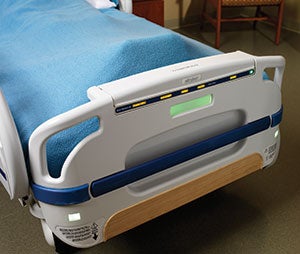Health care furniture gets technology boost

The iBed platform from Stryker Corp. can monitor whether the bed exit alarm is armed or the side rail is up or down; basic patient characteristics, such as weight; and nursing protocols and procedures, such as turning a patient every two hours.
Health care furnishings with monitoring functions can provide important data for patient care and facility operations.
The iBed platform, part of the Connected Hospital system from Stryker Corp., Kalamazoo, Mich., can monitor the status of the patient bed, such as whether the bed exit alarm is armed or the side rail is up or down; basic patient characteristics, such as weight; and nursing protocols and procedures, such as turning a patient every two hours. The company says the solution can provide clinical leadership with tools to track and drive compliance with fall prevention or patient care protocols to help provide a safer patient environment.
Wireless alerts sent through the iBed Awareness System using a facility’s existing third-party infrastructure allow caregivers to remotely monitor whether a bed is in a safe configuration as defined by hospital protocols. The iBed Locator also can help biomedical engineering or maintenance teams to find specific beds for scheduled preventive maintenance.
Also in this article |
| Internet of Things transforms health facility operations |
| Medical devices keep off-site patients connected |
|
|
Herman Miller, Zeeland, Mich.,and EarlySense, Waltham, Mass., are partnering to make a select offering of Nemschoff patient seating preconfigured for use with the EarlySense patient monitoring system. EarlySense is an integrated patient monitoring platform that operates via a sensor that communicates readings from patient beds or seating. The sensor, which requires no direct contact with the patient, continuously monitors a patient’s heart and respiratory rates, as well as movement in and out of the bed or chair.
These data are displayed at the bedside (or in clinical settings like infusion bays, next to the patient chair) on a central display screen that can be viewed throughout the department and on a display screen at the nurse station. The system also can send messages to nurses’ individual pagers or smartphones.
Zachary Palace, M.D., medical director at the Hebrew Home at Riverdale, New York City, says continuous monitoring allows caregivers to review real-time and trend data that may reveal a serious health issue, like impending sepsis. “If it’s picked up earlier because of monitoring systems that can identify these changes earlier, then we can intervene sooner and improve patient care,” he says.
Joel Van Wyk, director of product management, Herman Miller Healthcare, says, “Health care spaces are full of technology, and we continually explore ways in which our products can embrace these leading-edge technologies to positively impact the patient and caregiver experience.” With the EarlySense system, the furniture and technology “work together seamlessly, allowing the technology to evolve without making the furniture obsolete,” he says.




